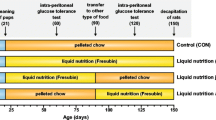Abstract
OBJECTIVE: To determine whether the slimming effects of treatment with oleoyl-estrone (OE) in liposomes of normal and obese rats are permanent, or disappear as soon as the treatment with the drug ceased. This study was devised to gain further knowledge on the postulated role of OE as a ponderostat signal, evaluating whether (in addition) it can lower the ponderostat setting of the rat.
DESIGN: The rats were infused for 14 d (using osmotic minipumps) with oleoyl-estrone in liposomes at a dose of 3.5 μmol/kg· ·d, and were studied up to one month after the treatment ceased.
SUBJECTS: Young adult lean controls (CL) or treated (TL) and obese controls (CO) or treated (TO) Zucker rats.
MEASUREMENTS: Energy balance, blood glucose, liver glycogen, plasma insulin, leptin corticosterone, ACTH and estrone (free and total) concentrations, and expression of the OB gene in white adipose tissue (WAT).
RESULTS: The loss of body weight caused by OE was recovered quickly in the TO, which gained weight at the same rate as the CO. TL rats, however remained at the low weight attained for one month after the treatment ceased. However, no differences were observed in calculated energy expenditure (EE) between the TL and TC rats once treatment had stopped. In TL and TO rats, liver glycogen concentrations decreased to normal shortly after treatment ceased, and leptin expression and concentrations remained normal and unchanged after the end of OE treatment. In TO rats, plasma glucose, insulin and leptin were lower than in the CO. Total estrone concentrations decreased rapidly in TL rats and more slowly in the TO, and free estrone followed a similar pattern.
CONCLUSION: Continuous infusion of liposomes loaded with OE resulted in a decreased energy intake (EI), maintenance of EE and the utilization of body fat reserves in lean and obese rats alike. This process ended in obese rats as soon as the infusion ceased, so that even when the levels of free and total estrone in plasma remained high, there was a marked (and relatively fast) shift toward the basal situation, which translated into an increase in EI, maintenance of estimated EE and a marked buildup of energy stores. In lean rats, the effects of OE on leptin concentrations and OB gene expression persisted after infusion ended.
Similar content being viewed by others
Author information
Authors and Affiliations
Rights and permissions
About this article
Cite this article
Adán, C., Cabot, C., Vilà, R. et al. Oleoyl-estrone treatment affects the ponderostat setting differently in lean and obese Zucker rats. Int J Obes 23, 366–373 (1999). https://doi.org/10.1038/sj.ijo.0800828
Received:
Revised:
Accepted:
Published:
Issue Date:
DOI: https://doi.org/10.1038/sj.ijo.0800828
- Springer Nature Limited
Keywords
This article is cited by
-
Comparative effects of oleoyl-estrone and a specific β3-adrenergic agonist (CL316, 243) on the expression of genes involved in energy metabolism of rat white adipose tissue
Nutrition & Metabolism (2010)
-
Action Profile of the Antiobesity Drug Candidate Oleoyl‐Estrone in Rats
Obesity (2010)
-
Site-specific modulation of white adipose tissue lipid metabolism by oleoyl-estrone and/or rosiglitazone in overweight rats
Naunyn-Schmiedeberg's Archives of Pharmacology (2010)
-
Site-related white adipose tissue lipid-handling response to oleoyl-estrone treatment in overweight male rats
European Journal of Nutrition (2009)
-
Maternal Treatment With Oleoyl‐estrone Induces Resistance to Lipid Accrual in Their Descendants
Obesity (2008)




